Invasive Species Week
Today marks the beginning of the fifth annual Invasive Species Week, led by the GB Non-native Species Secretariat. Organisations across the UK, Ireland, the Isle of Man, Guernsey and Jersey are working together on a week of action to raise awareness of invasive non-native species, their impacts, and the simple things that everyone can do to help prevent their spread. Find out more about invasive non-native species and some of the APHA projects involved in helping to prevent their spread, below.
What are invasive non-native species?
Around 2,000 animals and plants from all over the world have been introduced to Britain by people, as ornamental plants, exotic pets and accidental hitchhikers to name just a few ways. Most of these “non-native species” are harmless, but 10 – 15% of such species spread and become invasive, harming the environment and our wildlife, costing the British economy over £1.7 billion a year and even posing a risk to our health and the way we live. Once established, invasive species can be extremely difficult to manage and the damage they cause is irreversible. Their impacts are felt across a range of important environments and native wildlife.
Freshwater
Lakes, rivers, streams and other freshwaters are particularly vulnerable to invasion by species such as floating pennywort, originally introduced as an ornamental pond plant. In the wild it forms dense mats that can grow up to 20 cm per day under the right conditions, affecting oxygen levels in the water, crowding out and killing off native wildlife, and damaging important habitat. In 2017 the Environment Agency removed over 1,000 tonnes of floating pennywort, mostly from the Thames, Cam and Ouse River catchments where it blocks waterways making it difficult to use them for navigation, and increases the risk of flooding.
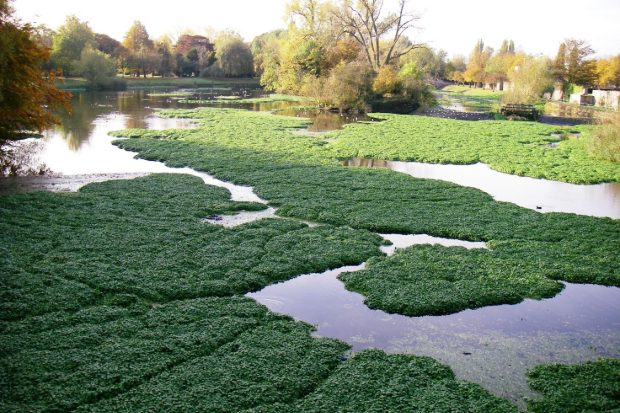
Woodland and bogs
Woodlands are a crucial part of our landscape and cultural heritage and home to some of the country’s rarest wildlife, but the biodiversity they support is threatened by a number of invasive species.
A dense sea of purple rhododendron flowers may look attractive when in bloom, but once rhododendron has become established, few native plants in that area will survive. Only trees which are able to grow above the level of the rhododendron canopy will persist and when those trees die, they cannot be replaced as seedlings are unable to establish under the lightless canopy. Each rhododendron flower produces several thousand seeds per year making it difficult to control.
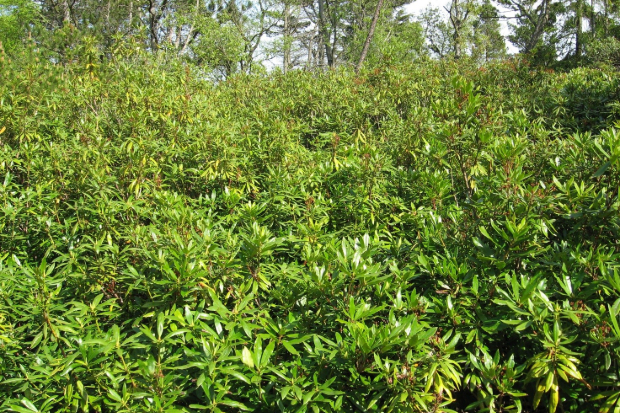
Woodland plants are also at risk from grazing by non-native mammals. Muntjac browsing in woodland can prevent tree regeneration and clear brambles and other shrubs, which has a profound effect on birds, butterflies and other animals which depend on the shrub and ground layer for food or shelter.
Marine
Like the freshwater environment, marine habitats are extremely vulnerable to invasive species due to their interconnectivity and widespread use for recreation and business. Alexia Fish, APHA’s RAPID LIFE project manager explains:
Marine invasive species often predate on our native species or outcompete them for essential resources such as light, space and food. This is the case with the Pacific oyster (Crassostrea gigas), an invasive species in the UK which can often form dense aggregations on beaches.
Other impacts can include hybridising with our native species such as the American lobster (Homarus americanus), which has the capacity to do this if it becomes established in the UK. American lobsters, like other invasive species also have the possibility of spreading diseases to our native species, who may be less well equipped to deal with them.Marine invasive species can also have significant economic impacts. A classic example of this in the UK is the carpet sea squirt (Didemnum vexillum), a very robust and highly invasive marine invertebrate that can form large mats which can cover several kilometres and colonise both artificial and natural surfaces. This species is often responsible for the smothering of shellfish beds and ropes, and the fouling of ships’ hulls and aquaculture equipment.
Trying to manage the impacts of marine INNS can become very labour-intensive and expensive. Though for some species, control methods are available, the best course of action is prevention, by practicing good biosecurity. Other marine biosecurity resources (such as hull fouling information, guidance on how to write a biosecurity plan, case studies on marine INNS etc.) can also be found on the RAPID LIFE webpages.
The RAPID LIFE Project is an EU funded 3 year LIFE project, led by APHA in partnership with Natural England and Bristol Zoological Society. The project addresses invasive species in high priority aquatic environments, including oceans.
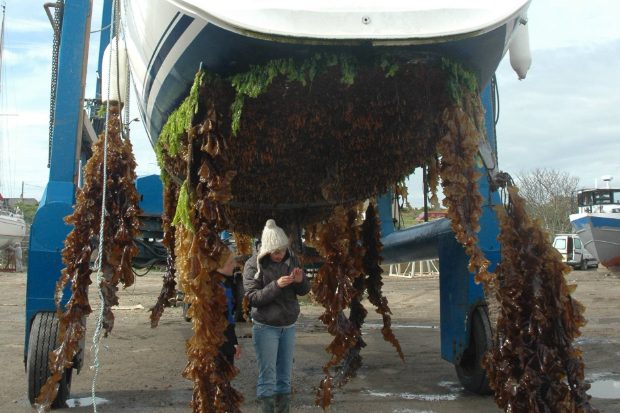
Urban
In our towns and cities, buildings and infrastructure are damaged by invasive plants such as Buddleja. This species is a particular threat to listed buildings, where it is often found rooting in cracks. The estimated annual damage costs to UK properties, both historical and private, from this species alone is £960k.
The release of unwanted pets is a key pathway of introduction of invasive species, which affects urban parks and ponds along with the wider countryside. Huge numbers of terrapins were imported into the pet trade following a popular TV series in the late 1980s, many were then released into ponds when they grew large, where they outcompete and prey on native wildlife.
The overall rate of new introductions has continued to rise with the ever increasing movement of humans and goods around the world. In 2004, the Asian hornet, a significant threat to honeybees and other pollinators, was introduced to France and is now widespread in parts of France, Spain, the Channel Islands and Portugal. Since 2016 a number of sightings have been recorded in the UK and staff from across APHA have been involved in the response. No Asian hornets have been seen in the UK since 14 October 2018, but with the arrival of spring APHA’s National Bee Unit are asking everyone to look out for Asian hornet and report any sightings immediately.
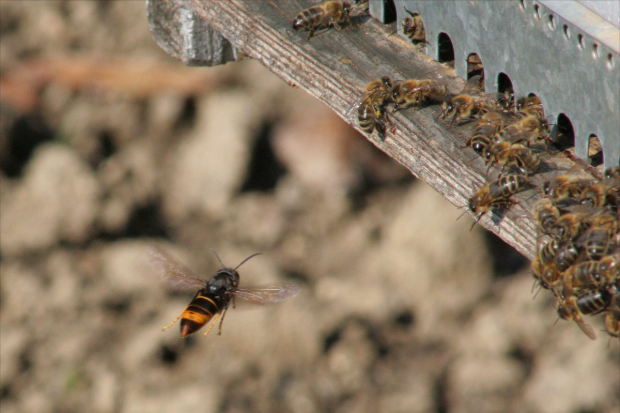
Small islands
The impacts of invasive species are often far worse on small islands than elsewhere because the native wildlife has evolved in isolation from predators, competitors and diseases. As a result native species are less able to compete and defend themselves in the face of new threats. The introduction of non-native mammalian predators including rats, mice, and mink to islands all over the world has contributed to declines and extinctions of a number of rare bird species.
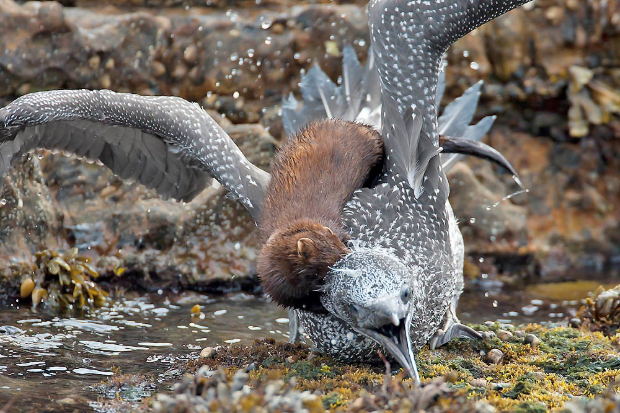
The UK has 14 Overseas Territories (OTs) and three Crown Dependencies, all of which are islands except for the British Antarctic Territory, Cyprus Sovereign Base Areas and Gibraltar. The OTs together account for 94% of the UKs unique biodiversity and as such make a significant contribution to global biodiversity.
Invasive non-native species are probably the greatest environmental threat to the OTs. However, most of them have limited capacity to act and need urgent support to develop measures to reduce the risk of future invasions as well as to manage existing ones.
In 2016 the GB NNSS secured funding over four years (2016-2020) under the FCO’s Conflict, Stability and Security Fund (CSSF) to develop comprehensive biosecurity for the OTs by providing them with access to UK expertise on risk analysis, pathway management, pest identification, horizon scanning, contingency planning, rapid response capability and species management. Find out more about the project here.
What can I do to help?
There are simple things that everyone can do to help protect the environment:
- If you’re an angler, canoeist, boater or similar, remember to Check Clean Dry your kit after leaving the water to avoid spreading invasive species between waterbodies. It’s even more important if you’re abroad as you could bring back new plants and animals.
- Be Plant Wise when planning a clear out of your garden, pond or aquarium, dispose of plants responsibly and don’t dump them in the wild where they could become invasive.
- Take care of your pets, never release them or allow them to escape into the wild. It’s cruel and could harm other wildlife.
- Help us to look out for Asian hornet. Suspected sightings can be reported online at www.nonnativespecies.org/alerts/asianhornet through the Asian Hornet Watch app for Android or Apple smartphones, or by sending a photo to alertnonnative@ceh.ac.uk. Free ID sheets and Alert posters for awareness raising are available from nnss@apha.gov.uk.
- If you enjoy being outside and want to try something new, there are Local Action Groups all over the country working on management of invasive non-native species. Contact nnss@apha.gov.uk to find your nearest group.
Find out more on the Invasive Species Week website or on Twitter @InvasiveSp, #InvasivesWeek and #GetINNSvolved.
For more information on the GB Non-native Species Secretariat, visit the website.

1 comment
Comment by Huw posted on
An informative blog, a good reminder that we've introduced non-native species into all environments. An insidious problem that starts almost unnoticed and seemingly of no real consequence...until populations have become firmly established and going back is then nigh on impossible. A terrible tragedy for endemic and unique island species to contend with, in addition to the ubiquitous plastic pollution of remote territories. Stewart McPherson's short series "Britain's Treasure Islands" featured a stark example of neighbouring islands...one hosted the deafening sound of birds...the other was silent, hosting invasive non-native species (introduced rats, mice..). Good luck with progressing this policy area...